
The Saxophone Family

The Eb Sopranino Saxophone
 The Sopranino saxophone is the highest pitched of all saxophones.
It plays one full octave above the alto, and 2 higher then the baritone.
The sopranino pictured is a Selmer series II, model number 50. The
sopranino isn't very popular for many reasons, the lack of literature and
accessories, especially reeds and mouthpieces, and that there many "big"
names whom play this instrument. I would manly get this instrument
for if you just want to fool around with one. You can identify the
sopranino from the soprano since it is slightly smaller than the soprano.
The Sopranino is available in both straight and curved versions, the curved
resembling a smaller version of the alto saxophone.
The Sopranino saxophone is the highest pitched of all saxophones.
It plays one full octave above the alto, and 2 higher then the baritone.
The sopranino pictured is a Selmer series II, model number 50. The
sopranino isn't very popular for many reasons, the lack of literature and
accessories, especially reeds and mouthpieces, and that there many "big"
names whom play this instrument. I would manly get this instrument
for if you just want to fool around with one. You can identify the
sopranino from the soprano since it is slightly smaller than the soprano.
The Sopranino is available in both straight and curved versions, the curved
resembling a smaller version of the alto saxophone.
The A Soprano Saxophone
The A Soprano was made during a time of experimentation
(1915-25) in the Conn factory. As far as I know, no one else ever
manufactured an A soprano saxophone, so I doubt if any mouthpieces are
available for the A Soprano. I know very little about the A soprano,
so if you have any information, or images dealing with the A soprano, please
don't hesitate to e-mail them to
me.
The C Soprano Saxophone
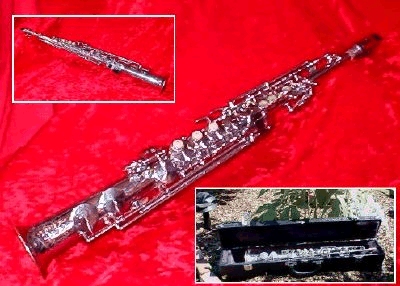 The C Soprano was made as a higher pitched version of the C melody tenor.
It was manufactured because of the "play-at-home" craze of the twenties.
The Soprano to the left is a C Soprano made by the H. N. White King company.
It was made sometime between 1923-24. It used to be for sale by The
Clarinet Doctor, cefield@aol.com.
Please go to the website more more details. The mouthpiece is slightly
smaller then that of a Bb Soprano, so using a Bb mouthpiece doesn't always
work, but in some cases it does. I'm sure someone must make C soprano
mouthpieces, although I'm not sure who. After the 20's, the production
of C Sopranos stopped, although the "left-overs" of the production run
were still sold, and listed in the company's show books. If you have anymore
information about the C Soprano, please e-mail
me.
The C Soprano was made as a higher pitched version of the C melody tenor.
It was manufactured because of the "play-at-home" craze of the twenties.
The Soprano to the left is a C Soprano made by the H. N. White King company.
It was made sometime between 1923-24. It used to be for sale by The
Clarinet Doctor, cefield@aol.com.
Please go to the website more more details. The mouthpiece is slightly
smaller then that of a Bb Soprano, so using a Bb mouthpiece doesn't always
work, but in some cases it does. I'm sure someone must make C soprano
mouthpieces, although I'm not sure who. After the 20's, the production
of C Sopranos stopped, although the "left-overs" of the production run
were still sold, and listed in the company's show books. If you have anymore
information about the C Soprano, please e-mail
me.
The Bb Soprano Saxophone
 The Soprano saxophone is the second highest pitched saxophone, second to
the sopranino. The soprano saxophone plays in the key of Bb, one
octave higher then the tenor, and two octaves higher then the mighty bass
saxophone. This saxophone offers a medium sized range of literature,
and a rather large amount of available accessories, such as mouthpieces
and reeds. This saxophone has started gaining rather large appeal
since the great Kenny G started performing with it, if you have never heard
Kenny play this beautiful instrument, you are missing a lot. The
soprano pictured is the Selmer Series III, with a high F# key and
a new high G key. Also, the Selmer series III soprano has two necks,
the normal straight neck, and a more comfortable slightly bent neck.
The soprano requires a stronger embouchure to play, much stronger then
the alto or tenor saxophone's "loose" embrasure. Also I have been
told that hitting notes in the altissimo register is harder due to it's
straight body. You can identify the soprano from all the saxophones
under it because it is generally straight, not curved like the alto tenor.
The Soprano is available in both a straight and curved version, the curved
being similar to an alto saxophone.
The Soprano saxophone is the second highest pitched saxophone, second to
the sopranino. The soprano saxophone plays in the key of Bb, one
octave higher then the tenor, and two octaves higher then the mighty bass
saxophone. This saxophone offers a medium sized range of literature,
and a rather large amount of available accessories, such as mouthpieces
and reeds. This saxophone has started gaining rather large appeal
since the great Kenny G started performing with it, if you have never heard
Kenny play this beautiful instrument, you are missing a lot. The
soprano pictured is the Selmer Series III, with a high F# key and
a new high G key. Also, the Selmer series III soprano has two necks,
the normal straight neck, and a more comfortable slightly bent neck.
The soprano requires a stronger embouchure to play, much stronger then
the alto or tenor saxophone's "loose" embrasure. Also I have been
told that hitting notes in the altissimo register is harder due to it's
straight body. You can identify the soprano from all the saxophones
under it because it is generally straight, not curved like the alto tenor.
The Soprano is available in both a straight and curved version, the curved
being similar to an alto saxophone.
The Eb Alto Saxophone
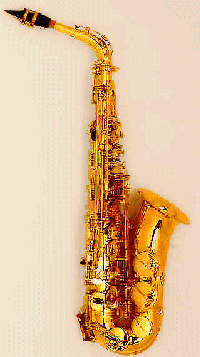 The alto saxophone is by far the most used and popular saxophone today.
Usually the alto saxophone is taught to the beginner to learn the basic
ideas of the saxophone, and then later plays multiple saxophones such as
the tenor and soprano. The alto has a nice mellow quality to it,
one that many people have grown to love. The alto has by far the
most literature and accessories ton offer, and many different brands of
reeds and mouthpieces. The alto plays in Eb, one octave below the
sopranino, and one octave higher then the baritone saxophone. One
of the reasons the alto is so popular is the fact that it is the middle
saxophone, not to high and not to low. Altissimo is easy to play
on this instrument mainly due to the fact it is curved.
The saxophone pictured is the Selmer Series II alto. The Selmer series
II has a high F# key and many other features that have become "standard".
You can identify the alto from the tenor because it has a straight neck,
not like the slight dip in the neck of the tenor.
The alto saxophone is by far the most used and popular saxophone today.
Usually the alto saxophone is taught to the beginner to learn the basic
ideas of the saxophone, and then later plays multiple saxophones such as
the tenor and soprano. The alto has a nice mellow quality to it,
one that many people have grown to love. The alto has by far the
most literature and accessories ton offer, and many different brands of
reeds and mouthpieces. The alto plays in Eb, one octave below the
sopranino, and one octave higher then the baritone saxophone. One
of the reasons the alto is so popular is the fact that it is the middle
saxophone, not to high and not to low. Altissimo is easy to play
on this instrument mainly due to the fact it is curved.
The saxophone pictured is the Selmer Series II alto. The Selmer series
II has a high F# key and many other features that have become "standard".
You can identify the alto from the tenor because it has a straight neck,
not like the slight dip in the neck of the tenor.
Straight Tenor and Alto Saxophone
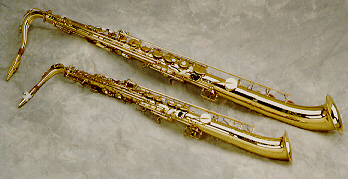 The straight alto and tenor saxophone has the same characteristics of their
curved counterparts, except they are straight. They were originally
made in the 40's, and have recently been made by
L.A. Sax. The straight alto and tenor saxophone is said to have
a brighter sound, similar to the soprano. List price for the alto
and tenor is between $3000 and $4800 depending on instrument and finish..
Please check the L. A. Sax home
page for more details.
The straight alto and tenor saxophone has the same characteristics of their
curved counterparts, except they are straight. They were originally
made in the 40's, and have recently been made by
L.A. Sax. The straight alto and tenor saxophone is said to have
a brighter sound, similar to the soprano. List price for the alto
and tenor is between $3000 and $4800 depending on instrument and finish..
Please check the L. A. Sax home
page for more details.
Image Copyright The L.A. Sax Company
1998
The C Melody Tenor Saxophone
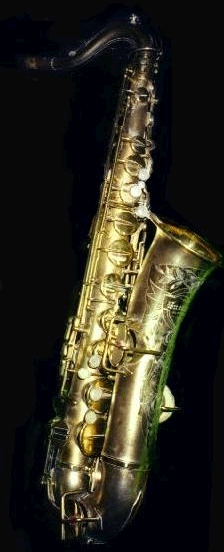 The C melody saxophone was most popular in the 1930's. Mos
The C melody saxophone was most popular in the 1930's. Mos t
families had one of these since it played in the key of C, so no transposing
was needed from vocal or piano music. C-melodies are usually quit
stuffy and in need of repair. One interesting C-melody was the Conn
gooseneck. Also most C-melodies came silver plated, but there were
exceptions. This saxophone had a slightly bent neck similar to that
of the newer sopranos. The C-melody lacks literature made for it,
but you can use most string music. Since the C-melody hasn't been
made in about 60 years, it is quite hard to find accessories for it, mainly
mouthpieces. Usually you have to use the mouthpiece that comes with
it, or buy one used. C-melodies can use regular tenor reeds, but
the tenor mouthpiece is to large, and the alto is to small. If you
find one under a hundred dollars and in good shape, you might want to get
one simply to mess around with. The C-melody to the left is a Buescher
with gold-plating, and it has a "tenor style" neck. The C-melody
to the right is a Conn with silver-plating, and it has an "alto style"
neck, and the Conn microtuner.
t
families had one of these since it played in the key of C, so no transposing
was needed from vocal or piano music. C-melodies are usually quit
stuffy and in need of repair. One interesting C-melody was the Conn
gooseneck. Also most C-melodies came silver plated, but there were
exceptions. This saxophone had a slightly bent neck similar to that
of the newer sopranos. The C-melody lacks literature made for it,
but you can use most string music. Since the C-melody hasn't been
made in about 60 years, it is quite hard to find accessories for it, mainly
mouthpieces. Usually you have to use the mouthpiece that comes with
it, or buy one used. C-melodies can use regular tenor reeds, but
the tenor mouthpiece is to large, and the alto is to small. If you
find one under a hundred dollars and in good shape, you might want to get
one simply to mess around with. The C-melody to the left is a Buescher
with gold-plating, and it has a "tenor style" neck. The C-melody
to the right is a Conn with silver-plating, and it has an "alto style"
neck, and the Conn microtuner.
The Bb Tenor Saxophone
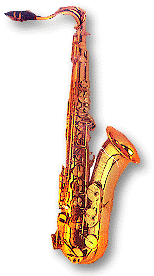 The Tenor Saxophone is usually called the jazz saxophone, although it is
used for all styles of music. The tenor saxophone played in the key
of Bb, one octave lower then the Soprano, and one octave higher then the
Bass saxophone. Altissimo is very easily achieved on the tenor, due
to it's size and shape. A wide variety of literature and accessories
are available for the tenor saxophone, a close second to the alto saxophone.
The saxophone pictured is a Selmer Series III tenor with a high F# key,
model 64. The series III tenor has a neck similar to the famous mark
VI. You can tell a Tenor from an alto saxophone simply by looking
at the neck, the tenor has a slight bend in it.
The Tenor Saxophone is usually called the jazz saxophone, although it is
used for all styles of music. The tenor saxophone played in the key
of Bb, one octave lower then the Soprano, and one octave higher then the
Bass saxophone. Altissimo is very easily achieved on the tenor, due
to it's size and shape. A wide variety of literature and accessories
are available for the tenor saxophone, a close second to the alto saxophone.
The saxophone pictured is a Selmer Series III tenor with a high F# key,
model 64. The series III tenor has a neck similar to the famous mark
VI. You can tell a Tenor from an alto saxophone simply by looking
at the neck, the tenor has a slight bend in it.
The Eb Baritone Saxophone
 The baritone saxophone plays in the key of Eb, one octave lower then the
alto saxophone, and two octaves lower then the sopranino. The baritone
saxophone is usually used in jazz ensembles, but can be used in other types
of music as well. The baritone does have a variety of accessories,
as well as mouthpieces and reeds, but these can get costly. The baritone
saxophone pictured is a Selmer series II. You can identify the baritone
from the saxophones that play in the higher keys because of the looped
neck.
The baritone saxophone plays in the key of Eb, one octave lower then the
alto saxophone, and two octaves lower then the sopranino. The baritone
saxophone is usually used in jazz ensembles, but can be used in other types
of music as well. The baritone does have a variety of accessories,
as well as mouthpieces and reeds, but these can get costly. The baritone
saxophone pictured is a Selmer series II. You can identify the baritone
from the saxophones that play in the higher keys because of the looped
neck.
The C Bass Saxophone
The C Bass saxophone was the first saxophone ever
made. Adolphe Sax made the first C Bass saxophone in 1842.
Hector Berlioz (French composer) apparently respected the instrument, and
transcribed some of his music for the C Bass at a demonstration concert
on February 3, 1844. As far as I know, the Sax family (his son took
over the company after 1894, when Adolphe died) were the only makers of
the C Bass. For some reason, it wasn't produced in the sax craze
of the twenties, when all the other c-melody saxes were being produced.
I have no pictures, and only this little amount of information of the C
Bass, so if you have any, please
e-mail
them to me.
The BBb Bass Saxophone
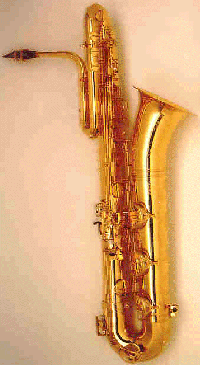 The bass saxophone is the largest saxophone that is still made today.
It plays in the key of Bb, one octave lower then the tenor, two octaves
lower then the soprano. The bass saxophone lacks both written music,
accessories, mouthpieces and reeds. The bass saxophone pictured is
a Selmer series II. If you get one of these, get ready to pay a lot
of money, these saxophones are hard to come by, usually special ordered,
and have a lot of metal in them so obviously, they are EXPENSIVE.
You can identify the bass saxophone from the baritone sax simply by the
curve in the neck being much larger on the bass, and the saxophone in general
is larger.
The bass saxophone is the largest saxophone that is still made today.
It plays in the key of Bb, one octave lower then the tenor, two octaves
lower then the soprano. The bass saxophone lacks both written music,
accessories, mouthpieces and reeds. The bass saxophone pictured is
a Selmer series II. If you get one of these, get ready to pay a lot
of money, these saxophones are hard to come by, usually special ordered,
and have a lot of metal in them so obviously, they are EXPENSIVE.
You can identify the bass saxophone from the baritone sax simply by the
curve in the neck being much larger on the bass, and the saxophone in general
is larger.
The Contrabass Saxophone
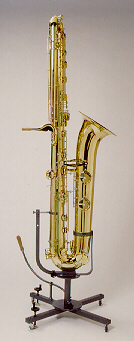
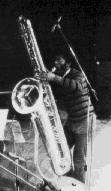 Only 17 original contrabass saxophones are believed to be in existence
today. One of the only companies that made this
monstrous instrument was Conn. It plays in the key of Eb. If
you want to hear what this sounds like, a few small saxophone ensembles
use the contrabass saxophone. One of them is the Nucleus Whales.
The Contrabass saxophone has few written parts, but it plays in the key
of Eb, so sopranino, alto, or baritone music can be played on it, only
it will sound a little low. It is just amazing how large these instruments
are. Of course written music and accessories, mouthpieces, and reeds
are hard to come by. You can identify the Contrabass from the other
saxophones mainly because of it's size. Also the curve in the neck
is VERY large. Recently,
L. A. Sax
has reintroduced this instrument, at a list price of around $37,500.
Image to the left Copyright The L.A.
Sax Company 1998.
Only 17 original contrabass saxophones are believed to be in existence
today. One of the only companies that made this
monstrous instrument was Conn. It plays in the key of Eb. If
you want to hear what this sounds like, a few small saxophone ensembles
use the contrabass saxophone. One of them is the Nucleus Whales.
The Contrabass saxophone has few written parts, but it plays in the key
of Eb, so sopranino, alto, or baritone music can be played on it, only
it will sound a little low. It is just amazing how large these instruments
are. Of course written music and accessories, mouthpieces, and reeds
are hard to come by. You can identify the Contrabass from the other
saxophones mainly because of it's size. Also the curve in the neck
is VERY large. Recently,
L. A. Sax
has reintroduced this instrument, at a list price of around $37,500.
Image to the left Copyright The L.A.
Sax Company 1998.
The Sub-Contrabass Saxophone
 The Sub-Contrabass Saxophone is the largest "saxophone" in existence.
About three are believed to have been made, one was for the 1899 Paris
Exposition. It was built by Avions Bleriot, and is in the key of
C. I must stress, most likely, they were not playable, most likely
a prop used for show. Quit obviously, the Sub-Contrabass saxophone
has little use, except for show. It is much to large to move easily,
and appears to take at least 3 people to play. There is an on-gowing
debate as to if any of the sub-contrabass saxes were ever playable, but
they are still quite marvelous to see.
The Sub-Contrabass Saxophone is the largest "saxophone" in existence.
About three are believed to have been made, one was for the 1899 Paris
Exposition. It was built by Avions Bleriot, and is in the key of
C. I must stress, most likely, they were not playable, most likely
a prop used for show. Quit obviously, the Sub-Contrabass saxophone
has little use, except for show. It is much to large to move easily,
and appears to take at least 3 people to play. There is an on-gowing
debate as to if any of the sub-contrabass saxes were ever playable, but
they are still quite marvelous to see.
Main About
the Webmaster News Basic Saxes
Company Specific Instructional
Linx
E-mail